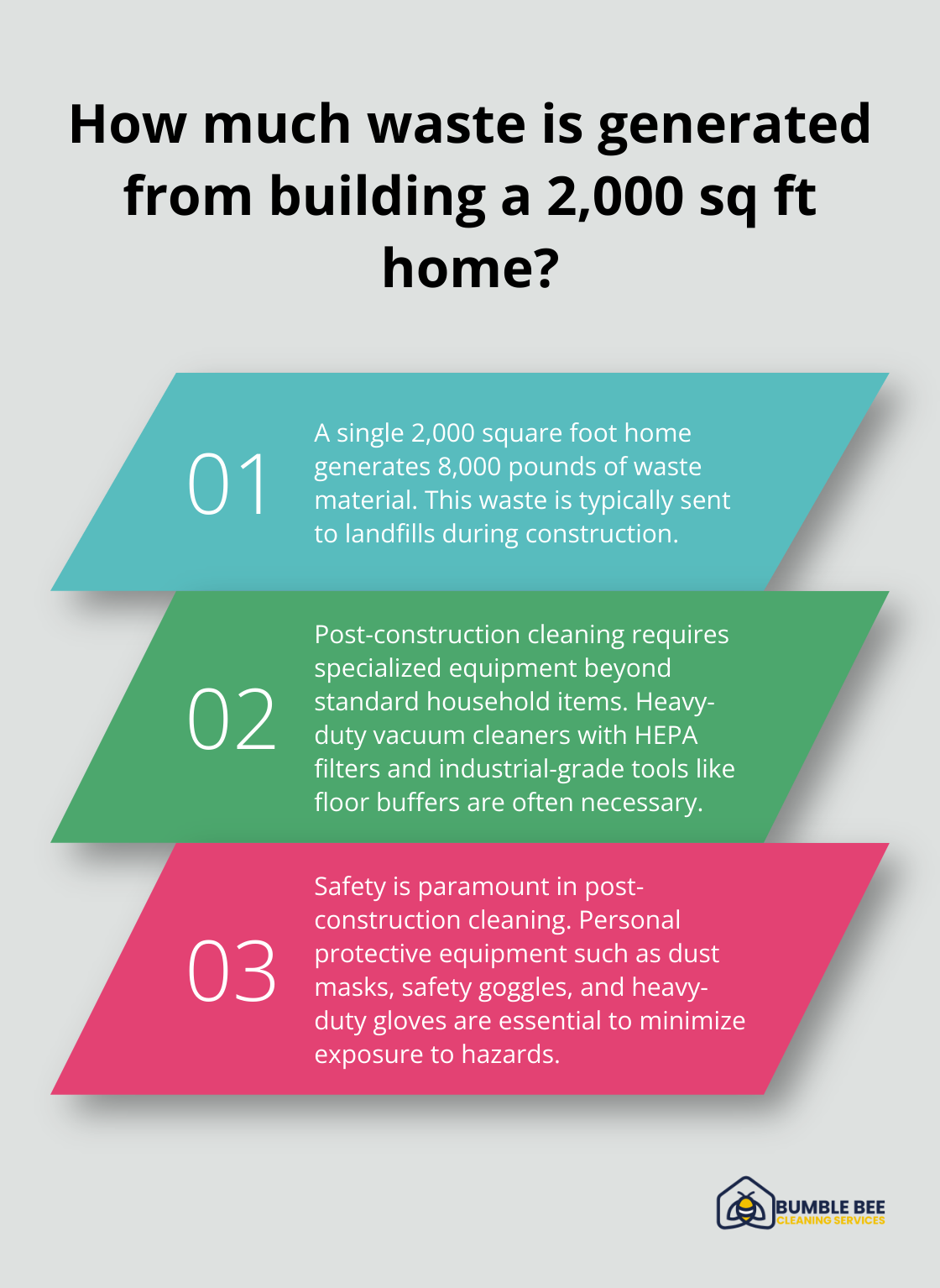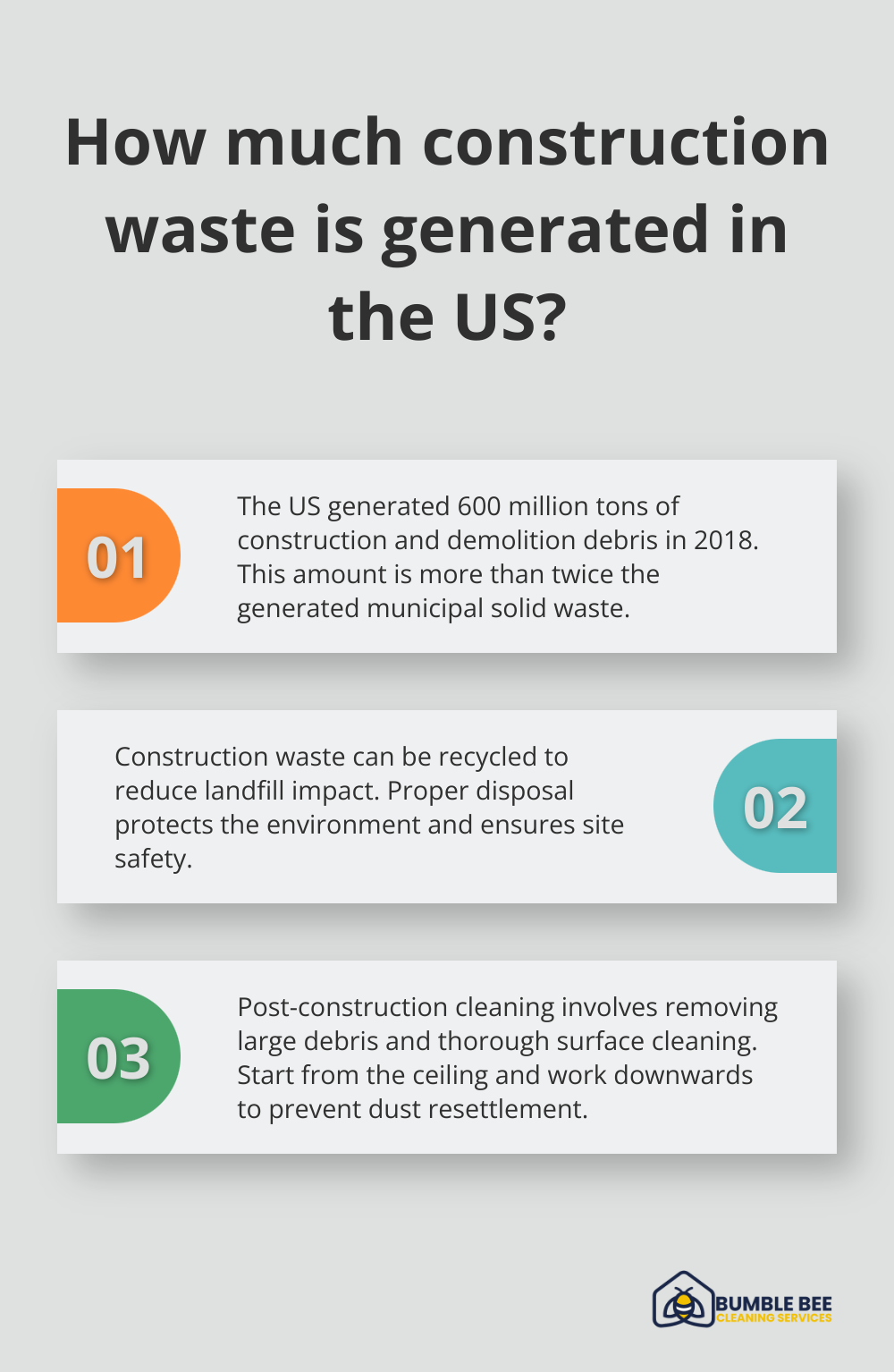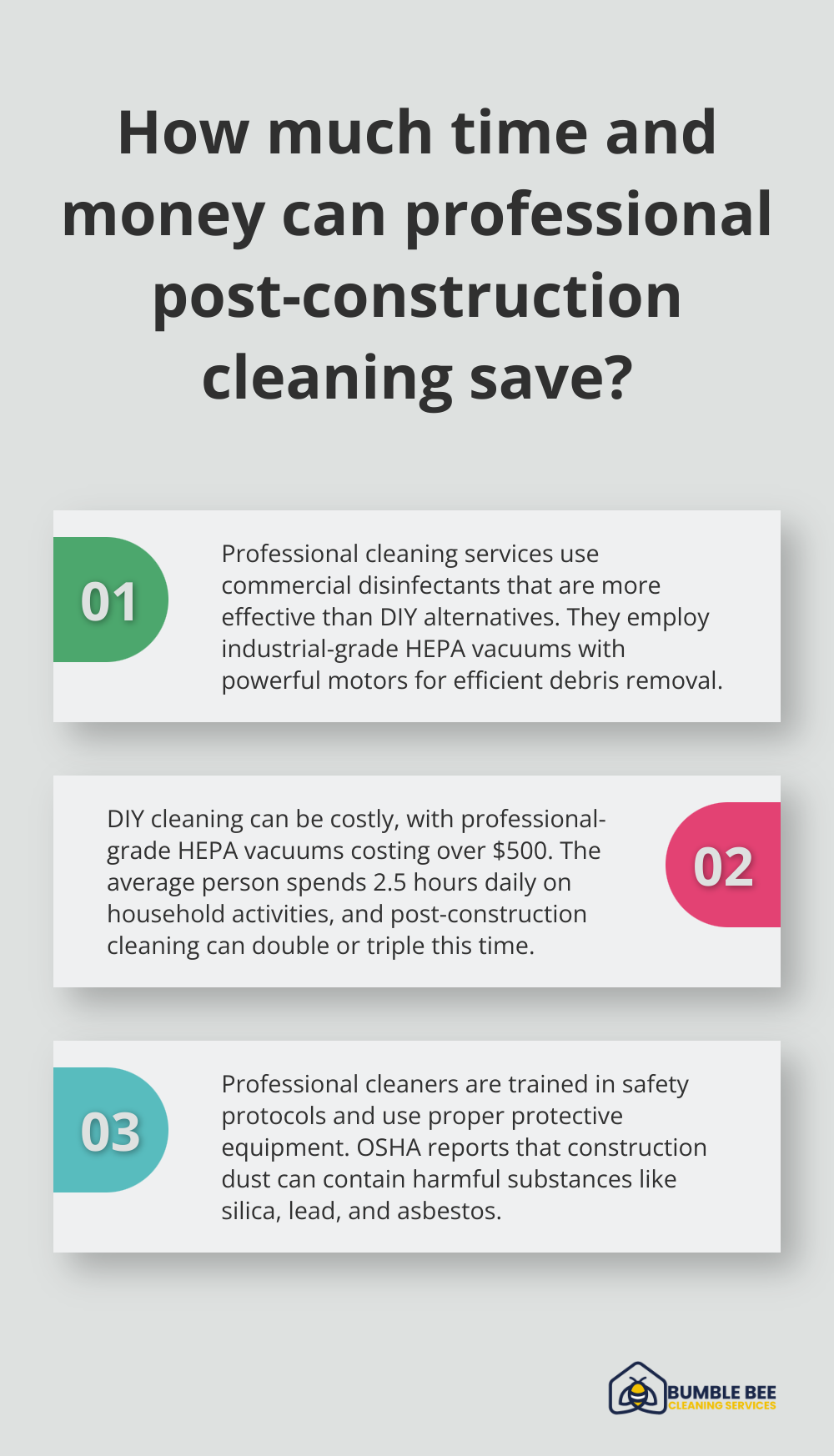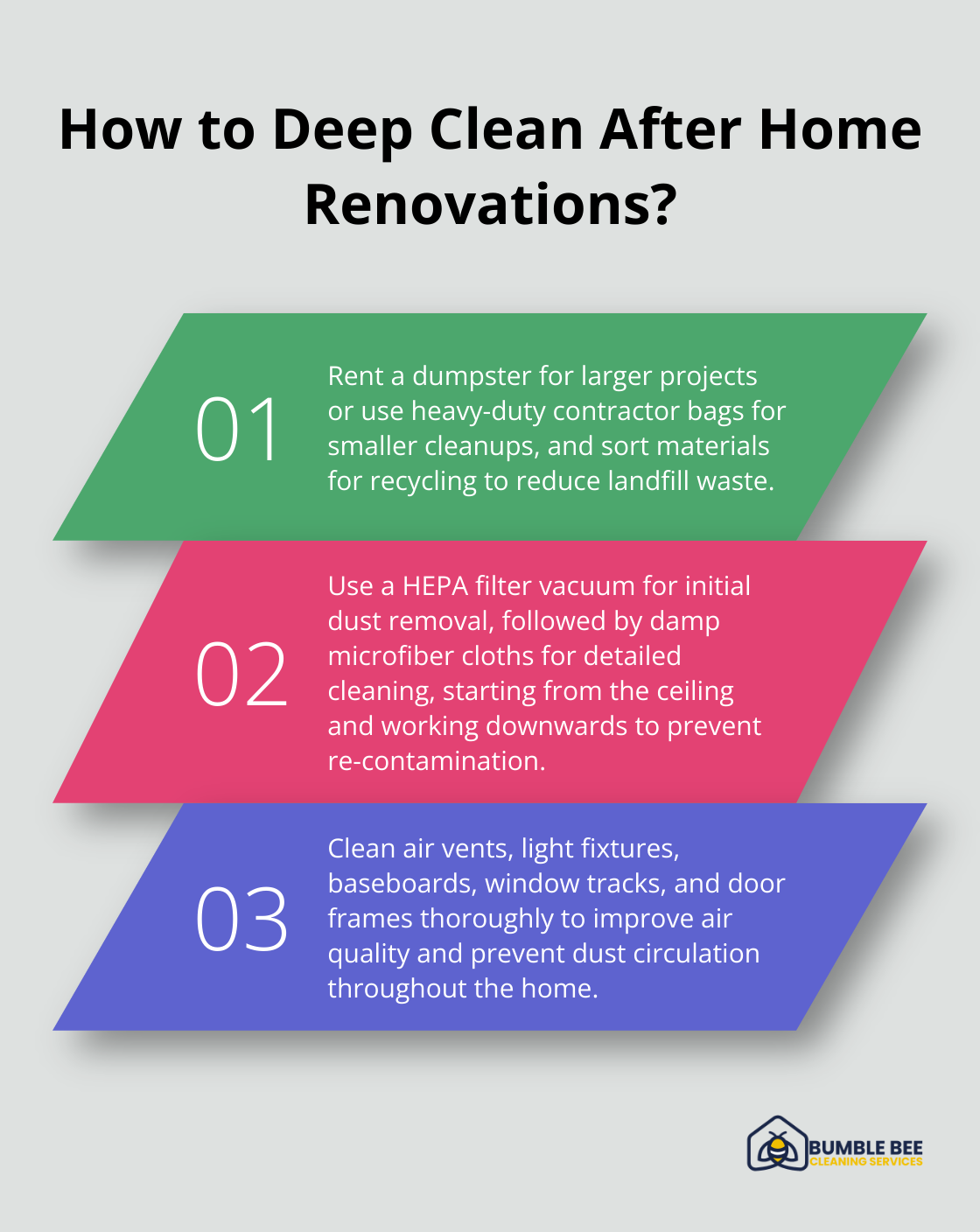At Bumble Bee Cleaning Services, we know that post-construction cleaning is a critical step in preparing a new build for occupancy. The process can be overwhelming, especially for Seattle homeowners who’ve just completed a major renovation or construction project.
Our ultimate checklist will guide you through the essential steps of new build cleaning, ensuring no detail is overlooked. From removing construction debris to deep cleaning every surface, we’ll help you transform your space into a pristine, move-in ready home.
How to Prepare for Post-Construction Cleaning
Post-construction cleaning requires careful planning and preparation. A well-organized approach will ensure a thorough and efficient cleanup process. Let’s explore the key steps to prepare for this significant task.
Assess the Cleanup Challenge
The first step is to evaluate the extent of debris and dust. Walk through each room and note areas with heavy dust accumulation, paint splatters, or leftover construction materials. This assessment will help you estimate the time and resources needed for the cleanup.

A study by the National Association of Home Builders estimates that 8,000 pounds of waste material get sent to the landfill when building a single 2,000 square foot home. Understanding the scale of the cleanup task is essential for effective planning.
Gather the Right Tools and Supplies
After assessing the situation, collect the necessary cleaning supplies and equipment. Post-construction cleaning requires more than standard household cleaning items. Here’s a recommended list:
-
Microfiber cloths and mops
-
All-purpose cleaner and degreaser
-
Glass cleaner
-
Scrub brushes and sponges
-
Buckets and spray bottles
-
Trash bags and a large debris container
For tough jobs, consider renting industrial-grade equipment like floor buffers or pressure washers. These tools can speed up the cleaning process and provide professional-level results.
Create a Systematic Cleaning Plan
A room-by-room cleaning plan enhances efficiency. Start with the rooms farthest from the exit and work your way towards the door. This prevents re-contamination of already cleaned areas.
Clean from top to bottom in each room. Begin with ceiling fans and light fixtures, then move to walls, windows, and finally, floors. This approach ensures that dust and debris settle on uncleaned surfaces, minimizing rework.
Prioritize Safety: Gear Up for the Job
Safety should be a top priority in post-construction cleaning. Proper safety gear protects you from dust, debris, and potentially harmful cleaning chemicals. Essential safety equipment includes:
-
Dust masks or respirators
-
Safety goggles
-
Heavy-duty gloves
-
Non-slip shoes
Personal protective equipment is worn to minimize exposure to hazards that cause serious workplace injuries and illnesses. Don’t underestimate the importance of safety gear in post-construction cleaning.
These preparation steps set the stage for a successful post-construction cleanup. However, the scale and complexity of post-construction cleaning often benefit from professional expertise. If you feel overwhelmed, consider reaching out to experienced professionals. Professional teams have the tools, knowledge, and experience to tackle even the most challenging post-construction cleaning projects efficiently and effectively.
Now that we’ve covered the preparation phase, let’s move on to the actual cleaning process itself.
How to Execute a Thorough Post-Construction Cleanup
Post-construction cleaning requires meticulous attention to detail and a systematic approach. This process transforms a construction site into a spotless living space. Let’s explore the essential steps to achieve a pristine environment after construction work.
Clear the Slate
The first step involves the removal of all large debris and leftover materials. This includes discarded packaging, drywall scraps, wood pieces, and other construction waste. The Environmental Protection Agency reports that 600 million tons of construction and demolition debris were generated in the United States in 2018, which is more than twice the amount of generated municipal solid waste. Proper disposal of this waste protects the environment and ensures site safety.

For larger projects, rent a dumpster. For smaller cleanups, use heavy-duty contractor bags. Sort materials for recycling where possible – many construction materials can find new life through repurposing or recycling, which reduces landfill waste.
Deep Clean from Top to Bottom
After clearing large debris, thoroughly clean all surfaces. Start with the ceiling and work downwards to prevent dust from settling on already cleaned areas. Use a HEPA filter vacuum for initial dust removal, then follow with damp microfiber cloths for detailed cleaning.
Clean walls, windows, and fixtures with a solution of warm water and mild detergent. For stubborn marks or paint splatters, use a magic eraser or specialized cleaning products. Exercise caution with abrasive cleaners on delicate surfaces to avoid damage.
Tackle High-Traffic Areas
Bathrooms and kitchens need special attention due to their frequent use and potential for harboring bacteria. Sanitize all surfaces, with extra focus on grout lines (which often trap construction dust). For kitchen appliances, clean both interior and exterior surfaces, including behind and underneath if they were moved during construction.
Restore Floor Brilliance
Different flooring types require specific cleaning approaches:
-
Carpets: Perform a deep steam clean to remove embedded construction dust.
-
Hardwood floors: Consider refinishing or at least a thorough polish to restore luster.
-
Tile and grout: Clean thoroughly, as construction dust can settle deep into grout lines.
For hardwood floors, vacuum and/or sweep the floor clean before sanding and after every cut. Inspect the floor carefully and look for protruding nail heads or staples. Set nails as necessary. For tile, try a mixture of baking soda and water to clean grout without harsh chemicals.
Address Often-Overlooked Areas
Don’t forget less obvious areas that can harbor dust and debris. Clean air vents and light fixtures thoroughly to improve air quality and lighting efficiency. Wipe down baseboards, window tracks, and door frames meticulously, as they often accumulate surprising amounts of dust.
The Indoor Air Quality Association emphasizes the importance of cleaning HVAC systems after construction to prevent the circulation of construction dust throughout the home.
While DIY cleaning is possible, many homeowners find that professional services provide superior results and save valuable time. Professional teams possess the experience and specialized equipment to address every nook and cranny, leaving newly constructed or renovated spaces truly move-in ready. In the next section, we’ll compare the benefits of professional cleaning services versus DIY approaches for post-construction cleanup.
Professional vs. DIY Post-Construction Cleaning: Making the Right Choice
The Professional Advantage
Professional cleaning services offer expertise and specialized equipment. Studies have shown that commercially formulated disinfectants are more effective than mix-at-home recipes suggested as alternatives. This efficiency translates to significant time savings for homeowners.

Professional teams use industrial-grade HEPA vacuums that are powered by motors generating enough suction to lift and remove heavier debris. This level of filtration removes fine construction dust, which can linger in the air and settle on surfaces long after cleaning.
The Hidden Costs of DIY
DIY cleaning might seem cheaper upfront, but it often comes with hidden costs. Renting or purchasing specialized equipment can be expensive. A professional-grade HEPA vacuum can cost upwards of $500. DIY cleaners may also need to invest in various cleaning supplies and safety equipment.
Time is another significant factor. The Bureau of Labor Statistics reports that the average person spends 2.5 hours per day on household activities. Post-construction cleaning can easily double or triple this time commitment, taking away from work or leisure activities.
Safety Considerations
Post-construction environments pose unique safety challenges. The Occupational Safety and Health Administration (OSHA) reports that construction dust can contain harmful substances like silica, lead, and asbestos. Without proper training and equipment, DIY cleaners may expose themselves to these hazards.
Professional cleaning teams receive training in safety protocols and use appropriate personal protective equipment. They also understand how to properly dispose of hazardous materials, ensuring compliance with local regulations.
Efficiency and Thoroughness
Professional cleaners bring years of experience to the job. They know which areas require special attention and have techniques to clean efficiently. This expertise often results in a more thorough clean in less time.
DIY cleaners might miss areas that professionals routinely address (such as air ducts or behind appliances). These overlooked spots can harbor dust and debris, potentially affecting indoor air quality.
Cost-Benefit Analysis
The choice between professional and DIY cleaning depends on your specific situation. For small projects, DIY might suffice. However, for larger renovations or new constructions, professional services often provide the best value in terms of time, safety, and results.
Consider your budget, time constraints, and the complexity of the cleaning job when making your decision. While DIY might save money in the short term, the long-term benefits of professional cleaning (including time saved and potential health benefits from a more thorough clean) often outweigh the initial cost.
Final Thoughts
Post-construction cleaning transforms Seattle homes into livable spaces. New build cleaning enhances aesthetic appeal and creates a healthy environment for occupants. Proper planning, systematic approaches, and attention to detail ensure successful cleanup operations.

The cleaning process addresses large debris removal and tackles often-overlooked areas. Professional post-construction cleaning services offer significant benefits over DIY approaches. Bumble Bee Cleaning Services brings expertise and specialized equipment to efficiently clean construction sites.
A clean, safe living space after construction represents an investment in home longevity and family well-being. Professional help ensures no detail is overlooked during the cleanup process. We strive to create a fresh start in your newly constructed or renovated Seattle home.
